Vaccine Aluminum Travels Into The Brain
“Parents can be reassured that the trace quantities of aluminum in vaccines can’t possibly do harm.“
-Dr Paul Offit: Vaccine promoter, vaccine patent licensor, and self-appointed autism pundit, 2015
Most vaccines contain aluminum adjuvant, an ingredient necessary for stimulating a strong immune response and immunity. The aluminum is in the form of Al hydroxide and/or Al phosphate nanoparticles.
Aluminum has been used in vaccines since the 1920s. Despite this long history, aluminum adjuvant was not studied much beyond its role in vaccine efficacy. The safety of injected Al adjuvant was assumed, largely because aluminum is a normal (if unhealthy) component of many foods. Its one of the most common elements of the Earths crust. Its everywhere.
So consideration of Al adjuvant safety was entirely based upon studies of ingested aluminum. Ingested aluminum has a low absorption (about 0.3%), and when this low absorption is taken into account, there is good reason to expect vaccines to create aluminum toxicity. But that is not the subject of the present commentary. Commentary about the total amount of aluminum in vaccines can be found here: http://vaccinepapers.org/danger-aluminum-vaccines/
This article is concerned with the nanoparticulate form of aluminum in vaccines, and the unique way that AANs are transported around the body. The “kinetics” (how it moves around the body) is very different from ingested aluminum.
Ingested Aluminum Kinetics
Ingested aluminum enters the blood from the gut. In the blood, ingested aluminum is in a water-soluble ionic form, typically Al3+ or an aluminum complex*. This aluminum is separated into individual Al atoms, like ordinary salt dissolved in water. Ionic aluminum is toxic, but it is blocked from entering the central nervous system (CNS) by the blood-brain barrier (BBB), and it is rapidly filtered from the blood by the kidneys. Unless large amounts are consumed it does not cause a problem.
Below is a diagram illustrating how ingested aluminum moves through the body. The body’s natural defenses are adequate for preventing harm from normal, natural amounts of ingested aluminum.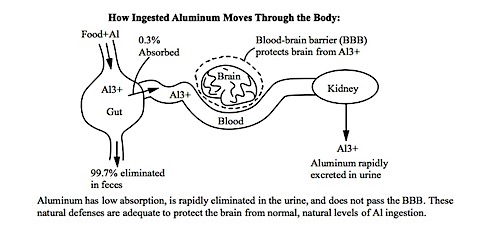
Based on on this understanding of ingested aluminum, it was long assumed that AAN follows a similar pathway out of the body. AANs cannot be filtered by the kidneys (they are too large). But it was assumed that the AANs would rapidly dissolve in body fluids, and the resulting Al3+ ions (or other Al ions like AlOH4-), would be filtered out by the kidneys, just like ingested aluminum. However, this simple model is wrong.
Below is a diagram illustrating this wrong understanding of how AANs travels through the body.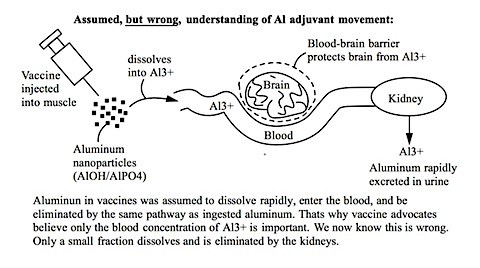
This model is wrong because what actually happens is that a type of white blood cell called a macrophage (MF) engulfs or “eats” (process is called “phagocytosis”) the AANs before they can dissolve. Eating foreign material is normal behavior for MFs. When MFs detect bacteria or other pathogens, the MFs engulf the pathogens, and digest them with enzymes. They then tell other immune system cells about the pathogen and how to detect it. MFs eat many types of nanoparticles.
The problem with AANs is that they are not digested by the MF enzymes. And the AANs, once inside the MF, dissolve much more slowly. The AANs persist for a long time (years) and cause the MFs to slowly leak aluminum. MFs that consume the AANs become highly contaminated with aluminum, and spread the aluminum wherever they go. And they go everywhere in the body. MFs generally do not travel in the blood, which explains why no aluminum is found in the blood after vaccination. MFs travel through the lymphatic system.
The MFs are able to travel across the blood brain barrier (BBB). The MFs, once loaded with AANs, act like a Trojan Horse and carry the AANs into the brain. This is harmful, because the brain is very sensitive to aluminum.
Below is a diagram of how AANs actually travels around the body.
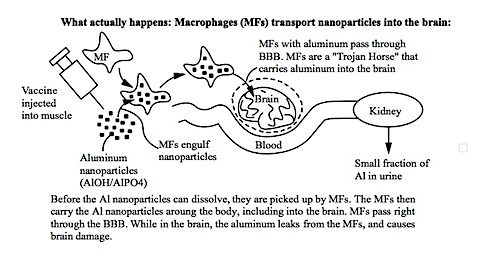
Once inside the brain, the aluminum damages brain cells. The damaged brain cells trigger inflammation which attracts more MFs, some of which are loaded with still more aluminum. The result is a vicious cycle.
A Pinch Is All It Takes
The brain is extremely sensitive to aluminum. Concentrations of aluminum as low as 10 nano-molar can cause inflammation of brain tissue. 10 nano-molar is 270 nano-grams aluminum per liter. (nano = 1 billionth). Thats an amazingly small amount.
For a typical brain weight of about 1400 grams, about 380 nano-grams (0.38 micrograms) of aluminum will produce an average concentration of 10 nano-molar. This is extraordinary, because a single vaccine can contain 250 micrograms (250,000 nano-grams), and an infant can receive about 3,675 micrograms in the first 6 months. In other words, just 0.01% of the aluminum in the first 6 months of vaccines is enough to cause inflammation of the entire brain (since 3,675 x 0.01% = 0.3675 micrograms).
Of course, this assumes perfectly uniform distribution of the aluminum in the brain, which is not realistic. However, this calculation establishes plausibility. The amount of aluminum in vaccines greatly exceeds the amount necessary to cause brain inflammation. Al adjuvant from vaccines can cause chronic brain inflammation.
MFs leaking aluminum into the brain will cause inflammation of brain tissue nearby. Thus there may be a “halo” of inflamed brain tissue surrounding each aluminum-loaded MF in the brain.
The Scientific Evidence
The scientific evidence for this “Trojan Horse” mechanism is quite simple, unequivocal and overwhelming. Every step has been proven by multiple studies from well-known universities and government-funded laboratories: the ingestion of AANs by MFs, the movement of MFs into the brain, and the observation that MFs carry nanoparticles into the brain.
First, there is the Flarend study, which shows that even after a month, only about 6% (of Al hydroxide) or 22% (of Al phosphate) are eliminated in urine. Most aluminum adjuvant is retained in the body 1 month after injection (94% of Al hydroxide is retained!). The Flarend study also shows that the aluminum spreads to numerous organs, including the brain.
Flarend paper: In vivo absorption of aluminium-containing vaccine adjuvants using 26Al
The Movsas study (published in 2013) used human infants and obtained similar results. Movsas looked for aluminum in urine and blood before and after routine vaccination with 1200mcg aluminum at the 2-month date. No change in urine or blood levels was observed. Movsas states:
“No significant change in levels of urinary or serum aluminum were seen after vaccination.“
Of course, these results contradict the claims by vaccine advocates that aluminum adjuvant dissolves into the blood and is removed by the kidneys. The reason why Movsas does not observe aluminum in blood or urine is because the aluminum is trapped in the MFs, which do not travel in the blood, and do not release aluminum into the urine.
Movsas paper: Effect of Routine Vaccination on Aluminum and Essential Element Levels in Preterm Infants
Several studies show, with certainty, that MFs engulf AANs. In several studies, the AANs have been stained and photographed inside the MFs, and identified using several different methods. This is not surprising because it is well known that MFs will spontaneously engulf nanoparticles when grown in a solution containing nanoparticles. The composition of the nanoparticles does not matter. MFs will engulf nanoparticles of any composition.
This paper describes an experiment proving that AANs are engulfed by human MFs, when grown in culture.
Paper (Mold et al): Unequivocal identification of intracellular aluminium adjuvant in a monocytic THP-1 cell line (Note: a macrophage (MF) is essentially the same as a “monocyte”. THP-1 is a specific macrophage culture used for research).
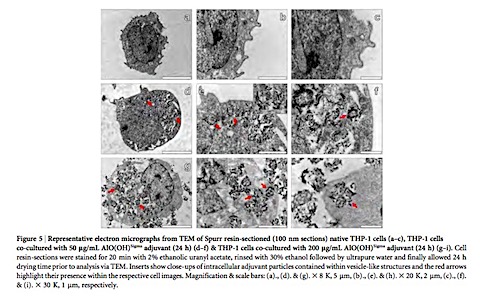
Above: Electron microscope images of aluminum adjuvant nanoparticles (AANs) inside macrophages (MFs). From Mold et al.
A study of macrophagic myofasciitis (MMF) patients observed AANs inside MFs at the location of intramuscular vaccine injections. Muscle tissue samples were obtained by biopsy 3 months to 8 years after vaccine injection (average: 36 months). Presence of aluminum inside MFs was confirmed by 3 different methods. Aluminum was present in MFs only, and not in muscle fibers.
Paper (Gherardi et al): Macrophagic myofasciitis lesions assess long-term persistence of vaccine-derived aluminum hydroxide in muscle.
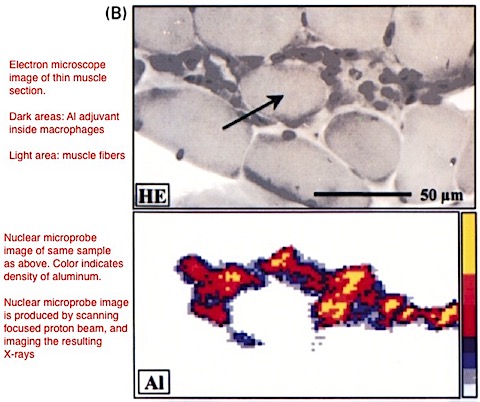
Above: Electron microscope (top) and nuclear microprobe (bottom) images of thin sections of muscle taken from macrophagic myofasciitis (MMF) patients. This study showed that AANs remain inside macrophages (MFs) in muscle tissue for up to 8 years after intramuscular injection. Nuclear microprobe is also called proton-induced X-ray emission (PIXE). From Gherardi et al. 2001.
Inflammation Causes Macrophage Movement
A 2009 study (D’Mello et al.) demonstrated that liver-specific inflammation (liver injury due to blocked bile duct) caused peripheral (“peripheral” = outside the CNS) MFs to enter the CNS. Specifically, microglia in the CNS detected the liver inflammation and became activated. The activated microglia released MCP-1 (also known as CCL2), which recruits macrophages into the brain. When MCP-1 is produced by microglia, macrophages from around the body travel into the brain. This is how AANs get into the brain. MCP-1 is described here: http://en.wikipedia.org/wiki/CCL2).
An interesting finding of the D’Mello study is that inflammation outside the CNS (i.e. peripheral inflammation) causes MFs to enter the CNS. The MFs will travel to the brain even if the original source of the inflammation is in the liver. Inflammation anywhere in the body may cause MFs to carry aluminum into the brain.
Paper (D’Mello et al.): Cerebral Microglia Recruit Monocytes into the Brain in Response to Tumor Necrosis Factor Signaling during Peripheral Organ Inflammation
AANs Photographed in Mouse Brain
In an impressive study in mice by Khan et al., AANs and other nanoparticles (e.g. latex) were injected intramuscularly. AANs were detected in the brain and spleen, up to one year later. These results contradict the long-assumed “100% of adjuvant dissolves into the blood” belief preferred by vaccine advocates.
Below is a page from this paper showing that AANs were detected in the brain and spleen.
Paper (Khan et al.): Slow CCL2-dependent translocation of biopersistent particles from muscle to brain
Khan observed that transport of AANs is MCP-1 dependent. This fact is further evidence that the macrophages are responsible for transporting the nanoparticles.
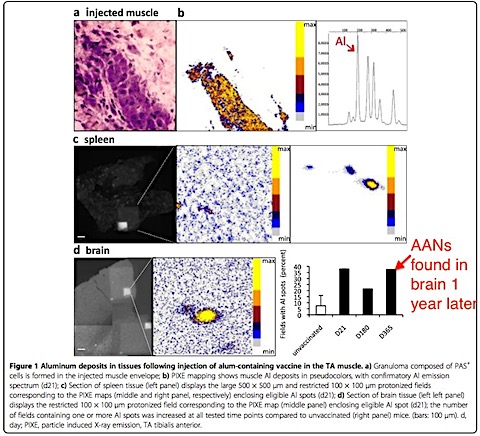
Above: Images of aluminum adjuvant nanoparticles (AANs) in brain and spleen of mice. These AANs traveled into the brain from the distant site of intramuscular injection. AANs are not rapidly dissolved and excreted, as vaccine advocates claim. D21, D180, D365 indicate time (in days) between AAN injection, and detection of AANs in the brain. From Khan et al 2013.
The Khan et al. paper concludes with this statement:
“…alum has high neurotoxic potential [49], and planning administration of continuously escalating doses of this poorly biodegradable adjuvant in the population should be carefully evaluated by regulatory agencies since the compound may be insidiously unsafe. It is likely that good tolerance to alum may be challenged by a variety of factors including overimmunization, BBB immaturity, individual susceptibility factors, and aging that may be associated with both subtle BBB alterations and a progressive increase of CCL2 production [50].”
CCL2/MCP-1 production is stimulated by immune activation. Hence, a vaccine that stimulates CCL2/MCP-1 may cause AANs (already in the body or from the vaccine) to move into the brain.
AANs from vaccines may remain harmlessly “dormant” at the injection site for years, until an immune activation event stimulates MCP-1 production. This will cause the macrophages containing AANs to mobilize and transport AANs into the brain and other sensitive tissues. This may explain some of the damage from the MMR vaccine. It is known that the measles vaccine stimulates MCP-1 production (Citation: http://www.ncbi.nlm.nih.gov/pubmed/24835247), as many infections can. Accordingly, the MMR vaccine can stimulate the movement of AANs (received from prior vaccines) into the brain. This may be a mechanism for MMR causing autism or other neurological damage.
Trojan Horse Technology Applications
The Trojan Horse mechanism of MF-transport of nanoparticles has been studied for applications in getting drugs into the brain (through the BBB). Studies have been done proving that nanoparticles (e.g. containing serotonin, cancer drugs, or HIV drugs) can be transported through the BBB using macrophages. In one specific study, the Trojan Horse mechanism was used to transport nanoparticles into a brain tumor. In this study, human MFs engulfed nanoparticles (made of silica-gold). The particle-loaded MFs were then injected into mice (into the tail) and the particle-loaded MFs were detected in the brain tumor 24 hours later. Paper: Delivery of nanoparticles to brain metastases of breast cancer using a cellular Trojan Horse This paper describes other experiments using MFs to transport materials into the brain:
“More than two decades ago, Fidler and colleagues provided evidence that macrophages of blood monocyte origin can infiltrate experimental brain metastases while the blood–brain barrier is intact (Schackert et al. 1988). Even earlier, Morantz and colleagues had quantified the content of macrophages in clinical specimens (Morantz et al. 1979).”
AND
“The use of monocyte/macrophages as delivery vehicles to the CNS has been investigated in situations other than malignancy. Afergan et al. demonstrated the delivery of serotonin to the brain by monocytes, which had phagocytosed nano-liposomes containing this otherwise brain impermeant drug (Afergan et al. 2008). Dou and colleagues utilized bone marrow derived macrophages as carriers of and depots for antiretroviral drugs to treat and attenuate the symptoms of HIV-associated neurocognitive disorder (Dou et al. 2009). Therefore, we hypothesized that nanoparticle-laden monocytes/macrophages would home in to intracranial metastatic deposits by crossing the blood–brain barrier following injection into the systemic circulation.”
CNS=central nervous system
It’s Proven
Every step has been proven: MFs engulf of Al nanoparticles, MFs cross the BBB and MFs carry nanoparticles into the brain. All these steps have been experimentally demonstrated and proven multiple times. And the entire process has been demonstrated with AANs in mice. AANs from an intramuscular injection were “photographed” in the brain by PIXE. These facts contradict the simplistic and wrong view (preferred by vaccine advocates) of aluminum toxicity based only on the concentration of dissolved aluminum ions in the blood. The story is far more complicated and worrisome than that. The toxicity of aluminum adjuvant is influenced by the transport of Al nanoparticles by MFs through the blood-brain barrier.
Elevated MCP-1/CCL2 in Autistic Brain
Further, MCP-1/CCL2 is elevated in the autistic brain and spinal fluid. This was one of the most significant findings of the Vargas study: Neuroglial Activation and Neuroinflammation in the Brain of Patients with Autism. Vargas stated:
“MCP-1 and TGF-B1 are the most prominent cytokines in the brain of autistic patients.”
AND
“MCP-1, a chemokine involved in innate immune reactions and important mediator for monocyte and T-cell activation and trafficking into areas of tissue injury, appeared to be one of the most relevant proteins found in cytokine protein array studies because it was significantly elevated in both brain tissues and cerebro-spinal fluid.“
Even vargas mentions the function of MCP-1 in causing movement of macrophages (monocytes).
This of course means that in autism, injected AANs will be transported by MFs into the brain from a distant intramuscular injection site. MCP-1 attracts macrophages, which are loaded with AANs by vaccination.
UPDATE: Nov 2015
A new study of Al adjuvant injections in mice has revealed even more complexity to the issue of Al adjuvant transport. As expected, it showed that Al adjuvant transport depends on MCP-1; mice that produce more MCP-1 (due to genetics) suffer greater transport of AANs into the brain.
Surprisingly, it also showed:
1) Transport depends on injection location. Subcutaneous injection (i.e. under the skin) is necessary for brain transport, at least for the dosages used. Intramuscular injection does not produce brain transport. This may be due to the presence of more-mobile white blood cells (dendritic cells) in the skin compared to muscle.
2) Transport depends inversely on dosage. A dosage of 200mcg/kg resulted in brain transport (and behavioral changes) and dosage of 400mcg/kg did not result in brain transport (and showed no behavioral changes). This may be due to the high dosage impairing macrophage mobility. For example, higher local inflammation at the injection site may cause reduced macrophage mobility.
There may also be an interaction between injection location and dosage. The dosage range that causes transport may be different for different tissues.
These phenomena may explain why the prior Al adjuvant injection experiments by the Shaw Laboratory (using 100, 300 and 550mcg/kg in divided doses) showed such strong adverse effects. Though aluminum adjuvant is harmful, in human infants the incidence of harmful effects is likely lower than what was observed in the prior mouse experiments. This has been a criticism made by vaccine advocates. Specifically, vaccine advocates have asserted that the Shaw Laboratory results were implausibly severe and thereforemust wrong. This new study may explain why adverse effects in human infants are less frequent than what was observed by the Shaw Laboratory.
The authors state:
“In previously published studies, motor and behavioral impairments were observed following sc (behind the neck) Alhydrogel® injection to CD1 mice with doses of 100 and 300 μg Al/kg [17,41]. These effects were associated with Al deposits in the central nervous system (spinal cord) assessed by Morin stain. To examine if the route of exposure may represent an important factor for alum toxicity, a nested study was conducted herein, showing that alum particles may penetrate the brain at D45 after the sc (and not im) injection, performed at the dose of 200 μg Al/kg (and not at the dose of 400 μg Al/kg). A higher rate of brain translocation after sc injection may be explained by a much higher density of dendritic cells with high migrating properties, in the skin compared to the muscle. The fact that half dose resulted in brain translocation, which was not observed at higher dose, is reminiscent of the non-monotonic dose/response curves previously observed with environmental toxins, including particulate compounds [67]. In another study, we similarly observed neurobehavioral changes at 200 but not 400 μg Al/kg (Crépeaux et al., manuscript in preparation). The exact significance of such observations is unknown, but one may speculate that huge quantities of alum injected in the tissue may induce blockade of critical macrophage functions such as migration and xeno/autophagic disposition of particles, as previously reported for infectious particles [37].”
sc=subcutaneous
im=intramuscular
Although this study does show that the adverse effects of Al adjuvant are less frequent than observed by the earlier experiments, it is confirmation of the Shaw laboratory results. This study is further evidence that Al adjuvant can cause brain damage at dosages human infants receive from vaccines.
Clearly, there is much more to learn about the dangers of Al adjuvant. The risk of Al adjuvant depends on genetics, on dosage in a complicated way, and on which tissue receives the injection.
Persistence
Another key finding from this study is the extreme biopersistence of Al adjuvant particles. The particles were observed in distant organs and tissues up to 270 days after injection, including in the brain, spleen and lymph nodes. This is confirmation of prior experiments that also found high persistence. Al adjuvant nanoparticles dissolve only very slowly, if at all, and travel extensively around the body.
The authors state:
“The present study confirms that alum is extremely biopersistent [29, 37] and that alum biopersistence can be observed in both the injected muscle and distant organs, including dLNs and spleen. Regarding the strong immunostimulatory effects of alum and the unrequired depot formation for its adjuvant activity [36], long-term biopersistence of alum in lymphoid organs is clearly undesirable, and may cast doubts on the exact level of long-term safety of alum-adjuvanted vaccines [37].”
dLNs = draining lymph nodes
alum = aluminum adjuvant
Full Paper (Crepeaux et al): Highly delayed systemic translocation of aluminum-based adjuvant in CD1 mice following intramuscular injections
Further reading: see this review paper by Dr Romain Gherardi (a co-author of the Khan et al paper): Biopersistence and brain translocation of aluminum adjuvants of vaccines
___________________________________________________________
NOTES:
AANs: Aluminum adjuvant nanoparticles. Used in most vaccines.
BBB: Blood brain barrier. Protects brain from aluminum in normal conditions.
MF: Macrophage (same thing as monocyte). A type of white blood cell. Can travel through the BBB.
CNS: Central nervous system (brain + spinal cord).
CCL2/MCP-1: Macrophage chemoattractant protein. Immune system signaling substance that attracts MFs. Causes MFs to transport aluminum into the brain and around the body.
* Under physiologic conditions, some dissolved aluminum will not be in the Al3+ form, but rather AlOH4-. For the sake of this discussion, this is irrelevant, so we will use Al3+, even though this is not really correct. But AlOH4- arguably contains Al3+ in the center.
Monocytes and macrophages are basically the same thing. From nature.com: “Macrophages (and their precursors, monocytes) are the ‘big eaters’ of the immune system. These cells reside in every tissue of the body, albeit in different guises — such as microglia (brain), Kupffer cells (liver) and osteoclasts (bone) — where they engulf apoptotic cells and pathogens and produce immune effector molecules. Upon tissue damage or infection, monocytes are rapidly recruited to the tissue, where they differentiate into tissue macrophages. Macrophages are remarkably plastic and can change their functional phenotype depending on the environmental cues they receive. Through their ability to clear pathogens and instruct other immune cells, these cells have a central role in protecting the host but also contribute to the pathogenesis of inflammatory and degenerative diseases.”
TO SE THE PAPERS IN THIS POST CLICK HERE (Original post)






You guys can know how you can buy research paper to continue your research while getting narrow down in a single topic.Most of the time it is hard to collect date for the research paper but now you can easily collect it here
research papers for sale cheap